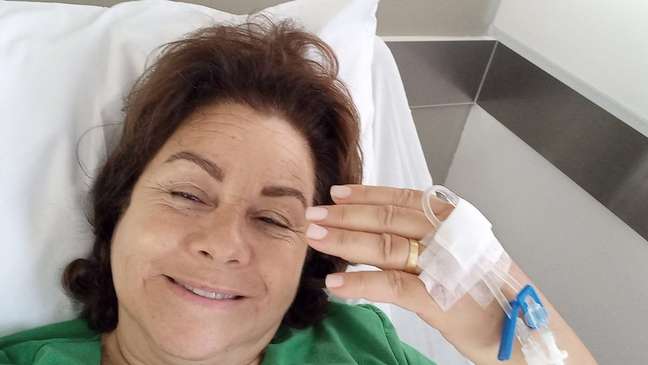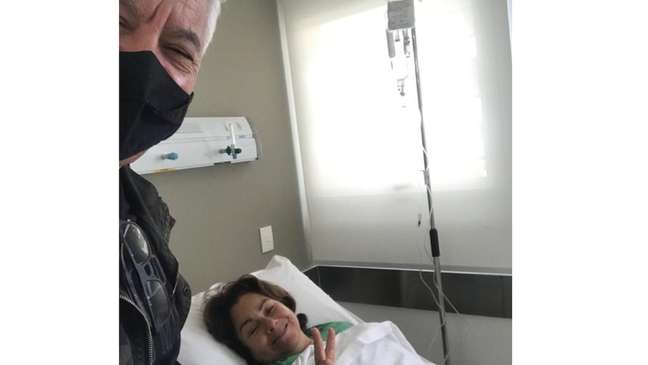After taking a chest X-ray to see if her breast cancer had metastasized, Simone discovered another, unrelated lung cancer.

Simone Barbosa, 67, has struggled for three decades to follow breast cancer screening recommendations issued by health organizations.
In Brazil, it is recommended that women start mammography examinations at the age of 40, even if there is no cancer in the family, according to bodies such as the Brazilian Federation of Gynecological and Obstetrics Associations (Febrasgo) and the Brazilian Society of mastology (SMB). The National Cancer Institute (Inca) and the Ministry of Health stress that the target should be 50 years.
Knowing that the risk of the disease increases with age, Simone has long included mammography in her annual checkup. But in 2020, with several medical services temporarily suspended due to the high demand for care caused by covid-19, she was unable to take the exams.
“I was already bothered by the situation, so when things got a little better in 2020, I followed that up and got checked up right away,” Simone says.
Mammography performed at the time showed a small lump in the breast which, when biopsied, was identified as malignant.
“After this diagnosis, as is usually done, we proceed to the staging of the cancer, i.e. the evaluation of the possible spread of the disease. In cases of breast cancer, the most common is that the metastases spread to the liver, bones and lungs, so we first focused on investigating these areas”, explains Leonidas Noronha, breast specialist and oncoplastic surgeon who followed Simone’s case.
The surprise, says the doctor, is that a pulmonary nodule was found in the chest X-ray, one of the tests required for staging.
“Because this test is simple, you can’t tell just by looking at the image whether the mass is from a primary tumor [outro câncer, sem relação com o de mama] or a metastasis.”
After a tomography, the specialist received an image of the tumor, large, about four centimeters, which indicated the case of a primary tumor – later confirmed by biopsy.
“In over 30 years of mastology, Simone was the first patient in whom I saw breast and lung cancer at the same time.”
The condition of two unrelated cancers, Noronha explains, is called synchronous cancers and is considered quite rare.
“There is no single answer as to why this happens. It could be related to a genetic predisposition, but this could only be confirmed with a DNA sequencing test.”
Simone says the surprise of the two cancers was even greater for having only one known case of cancer in the family: a sister who battled bladder disease. She, on the other hand, was a smoker, and smoking is the main risk factor for this type of cancer.
“I was very lucky”
Simone says she was lucky to discover the two tumors, especially the lung one, which is more difficult to cure because it only shows symptoms in an advanced stage.
“I was very blessed. I truly believe God gave me breast cancer so I could see lung cancer. I didn’t have any symptoms, so I wouldn’t have taken the test if it wasn’t for the early discovery.”
When lung cancer shows signs such as shortness of breath, coughing, chest pain and extreme weight loss it means the disease is already in an advanced stage (and with a high chance of metastasis).
In Simone’s case, neither tumor had spread to other parts of the body.

Treatment for two different types of cancer
The mastologist states that the treatment plan was jointly decided by him, the patient, a clinical oncologist and a thoracic surgeon.
“Because he already had an indication for chemotherapy due to the size of the largest tumor in his lung, we chose to start treatment in sessions.”
Then came breast surgery and finally lung surgery.
With conventional surgical methods, removing a tumor from the lung requires a more invasive approach to the patient’s body, resulting in extensive surgery and a long recovery time.
“Since I was about to have two surgeries in a short time, I opted for the robotic lung surgery option, which the doctors explained would cause less pain and a quicker return to routine,” Simone says.
According to Leonardo Rottili Roede, thoracic surgeon at the Marcelino Champagnat hospital, in Curitiba, the surgery is minimally invasive and has no cuts, but only thin incisions, which helps anyone involved in aesthetics.
The price, says the surgeon, is still high for the majority of the Brazilian population: it is between R $ 15,000 and R $ 20,000 for patients who, like Simone, have a health plan and benefit from coverage of part of the expenses. .
“But the price tends to go down over the years and with the evolution of technologies. About two years ago it cost R$ 50,000.”
What is done in surgery depends on the size of the lesion.
“Since Simone’s tumor was extensive, we removed one of the lung lobes, the upper left one,” Roede points out.
“At first she lost some of her breathing capacity, but after the surgery, with rehabilitation and pulmonary physiotherapy, she recovered. Today she is very close to what she was before.”
Simone’s last surgery turned one year old in November. Her treatment today is to take an oral hormone blocker that helps reduce the chances of her breast cancer coming back.
“Today she is in remission from the cancer, but like any patient who has had the disease, she needs to be followed up for several years,” says Noronhas, Simone’s doctor.
Treatment for metastatic cancer is more difficult
«When there is a diagnosis of breast cancer, but the staging shows that it is already metastatic, which was not the case for Simone, the way of thinking about the treatment changes», explains the mastologist.
Surgery no longer has an initial impact, as removing a tumor would not kill the cancer cells, which would continue to spread.
“The focus usually becomes systemic treatment such as immunotherapy, chemotherapy, and monoclonal antibody drugs. It’s a clinical, non-surgical line of treatment.”
The prognosis for metastatic cases is more difficult, but even if it’s not possible to go into remission (being disease-free), patients with the condition often manage to have a good quality of life, Noronhas says.
“With the new therapies we have today, patients with grade 4 breast cancer, for example, have active lives for many years, even more than a decade. A few years ago, the prediction was for a much shorter outcome.”
– This text was published in https://www.bbc.com/portuguese/geral-64033650
🇧🇷The best content in your email for free. Choose your favorite Terra newsletter. Click here!
Source: Terra
Ben Stock is a lifestyle journalist and author at Gossipify. He writes about topics such as health, wellness, travel, food and home decor. He provides practical advice and inspiration to improve well-being, keeps readers up to date with latest lifestyle news and trends, known for his engaging writing style, in-depth analysis and unique perspectives.







